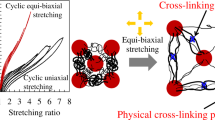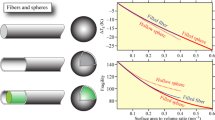Abstract
The relaxation of the local conformation of ethylene-propylene-diene terpolymer (EPDM) rubber at the quartz interface was examined by sum frequency generation (SFG) spectroscopy in conjunction with all-atom molecular dynamics (MD) simulations. At room temperature, SFG peaks due to the CH symmetric stretching vibration of methyl (CH3s) and methylene (CH2s) groups were observed, and the intensity was stronger for CH3s than for CH2s. The CH3s to CH2s intensity ratio was reversed during the heating process, meaning that the local conformation of EPDM at the interface changed. MD simulations revealed that the fraction of ethylene units in the trans conformation on the substrate surface decreased once the temperature was greater the interfacial glass transition temperature (Tg), which was determined based on the temperature dependence of the mass density. Moreover, the temperature-induced change in the fraction of propylene units in the trans conformation was less remarkable than that of ethylene units. Both SFG spectroscopy and MD simulation confirmed that the Tg was higher in the interfacial region than in the bulk.
This is a preview of subscription content, access via your institution
Access options
Subscribe to this journal
Receive 12 print issues and online access
$259.00 per year
only $21.58 per issue
Buy this article
- Purchase on Springer Link
- Instant access to full article PDF
Prices may be subject to local taxes which are calculated during checkout







Similar content being viewed by others
References
Ravishankar PS. Treatise on EPDM. Rubber Chem Technol. 2012;85:327–49.
Kresge EN. Science and serendipity in polyolefin elastomer development. Rubber Chem Technol. 2010;83:227–34.
Ismail H, Pasbakhsh P, Fauzi MNA, Abu, Bakar A. Morphological, thermal and tensile properties of halloysite nanotubes filled ethylene propylene diene monomer (EPDM) nanocomposites. Polym Test. 2008;27:841–50.
Candau N, Oguz O, Peuvrel-Disdier E, Bouvard JL, Pradille C, Billon N. Strain-induced network chains damage in carbon black filled EPDM. Polymer. 2019;175:329–38.
Nakanishi Y, Mita K, Yamamoto K, Ichino K, Takenaka M. Effects of mixing process on spatial distribution and coexistence of sulfur and zinc in vulcanized EPDM rubber. Polymer. 2021;218:123486.
Das A, De D, Naskar N, Chandra Debnath S. Effect of vulcanization technique on the physical properties of silica‐filled EPDM rubber. J Appl Polym Sci. 2006;99:1132–9.
Ahmadi SJ, Huang Y, Li W. Fabrication and physical properties of EPDM–organoclay nanocomposites. Compos Sci Technol. 2005;65:1069–76.
Öksüz M, Eroglu M, Yıldırım H. Effect of talc on the properties of polypropylene/ethylene/propylene/diene terpolymer blends. J Appl Polym Sci. 2006;101:3033–9.
Wang H, Wang H, Xu J, Du X, Yang S, Wang H. Thermo-driven self-healable organic/inorganic nanohybrid polyurethane film with excellent mechanical properties. Polym J. 2022;54:293–303.
Ciprari D, Jacob K, Tannenbaum R. Characterization of polymer nanocomposite interphase and its impact on mechanical properties. Macromolecules. 2006;39:6565–73.
Li B, Zhang S, Andre JS, Chen Z. Relaxation behavior of polymer thin films: effects of free surface, buried interface, and geometrical confinement. Prog Polym Sci. 2021;120:101431.
Uematsu H, Nishimura S, Yamaguchi A, Yamane M, Ozaki Y. Growth of polypropylene crystals in the vicinity of carbon fibers and improvement of their interfacial shear strength. Polym J. 2022;54:667–77.
Morimune-Moriya S. Polymer/nanocarbon nanocomposites with enhanced properties. Polym J. 2022;54:977–84.
Twiss D. The theory of vulcanisation. J Soc Chem Ind. 1925;44:106–8.
Pliskin I, Tokita N. Bound rubber in elastomers: analysis of elastomer-filler interaction and its effect on viscosity and modulus of composite systems. J Appl Polym Sci. 1972;16:473–92.
Griffin PJ, Bocharova V, Middleton LR, Composto RJ, Clarke N, Schweizer KS, et al. Influence of the bound polymer layer on nanoparticle diffusion in polymer melts. ACS Macro Lett. 2016;5:1141–5.
Kaufman S, Slichter WP, Davis DD. Nuclear magnetic resonance study of rubber−carbon black interactions. J Polym Sci A-2. 1971;9:829–39.
Nishi T. Effect of solvent and carbon black species on the rubber-carbon black interactions studied by pulsed NMR. J Polym Sci, Polym Phys Ed. 1974;12:685–93.
Litvinov VM, Steeman PAM. EPDM− carbon black interactions and the reinforcement mechanisms, as studied by low-resolution 1H NMR. Macromolecules. 1999;32:8476–90.
Litvinov VM, Orza RA, Klüppel M, van Duin M, Magusin PCMM. Rubber–filler interactions and network structure in relation to stress–strain behavior of vulcanized, carbon black filled EPDM. Macromolecules. 2011;44:4887–900.
Nguyen HK, Sugimoto S, Konomi A, Inutsuka M, Kawaguchi D, Tanaka K. Dynamics gradient of polymer chains near a solid interface. ACS Macro Lett. 2019;8:1006–11.
Richter D, Kruteva M. Polymer dynamics under confinement. Soft Matter. 2019;15:7316–49.
Sugimoto S, Inutsuka M, Kawaguchi D, Tanaka K. The effect of interfacial dynamics on the bulk mechanical properties of rubber composites. Polym J. 2020;52:217–23.
Fernández-de-Alba C, Jimenez AM, Abbasi M, Kumar SK, Saalwächter K, Baeza GP. On the immobilized polymer fraction in attractive nanocomposites: Tg gradient versus interfacial layer. Macromolecules. 2021;54:10289–99.
Kimura T, Hayashi M. Exploring the effects of bound rubber phase on the physical properties of nano-silica composites with a vitrimer-like bond exchangeable matrix. Polym J. 2022;54:1307–19.
Scheutjens JMHM, Fleer GJ. Statistical theory of the adsorption of interacting chain molecules. 2. train, loop, and tail size distribution. J Phys Chem A. 1980;84:178–90.
Marzolin C, Auroy P, Deruelle M, Folkers JP, Léger L, Menelle A. Neutron reflectometry study of the segment-density profiles in end-grafted and irreversibly adsorbed layers of polymer in good solvents. Macromolecules. 2001;34:8694–700.
Behbahani AF, Rissanou A, Kritikos G, Doxastakis M, Burkhart C, Polińska P, et al. Conformations and dynamics of polymer chains in cis and trans polybutadiene/silica nanocomposites through atomistic simulations: from the unentangled to the entangled regime. Macromolecules. 2020;53:6173–89.
Inutsuka M, Watanabe H, Aoyagi M, Yamada NL, Tanaka C, Ikehara T, et al. Effect of oligomer segregation on the aggregation state and strength at the polystyrene/substrate interface. ACS Macro Lett. 2022;11:504–9.
Yavitt BM, Salatto D, Zhou Y, Huang Z, Endoh M, Wiegart L, et al. Collective nanoparticle dynamics associated with bridging network formation in model polymer nanocomposites. ACS Nano. 2021;15:11501–13.
Salatto D, Carrillo JMY, Endoh MK, Taniguchi T, Yavitt BM, Masui T, et al. Structural and dynamical roles of bound polymer chains in rubber reinforcement. Macromolecules. 2021;54:11032–46.
Shen YR. Fundamentals of sum-frequency spectroscopy. Cambridge: Cambridge University Press; 2016.
Zhang C. Sum frequency generation vibrational spectroscopy for characterization of buried polymer interfaces. Appl Spectrosc. 2017;71:1717–49.
Aoki M, Shundo A, Okamoto K, Ganbe T, Tanaka K. Segregation of an amine component in a model epoxy resin at a copper interface. Polym J. 2019;51:359–63.
Harada R, Kawaguchi D, Yamamoto S, Tanaka K. Change in local conformation of polymer chains at film surface attached to solid surface. Soft Matter. 2022;18:3304–07.
Abe T, Shimada H, Hoshino T, Kawaguchi D, Tanaka K. Sum frequency generation imaging for semi-crystalline polymers. Polym J. 2022;54:679–85.
Tsuruta H, Fujii Y, Kai N, Kataoka H, Ishizone T, Doi M, et al. Local conformation and relaxation of polystyrene at substrate interface. Macromolecules. 2012;45:4643–49.
Inutsuka M, Horinouchi A, Tanaka K. Aggregation states of polymers at hydrophobic and hydrophilic solid interfaces. ACS Macro Lett. 2015;4:1174–8.
Baschnagel J, Binder K, Doruker P, Gusev AA, Hahn O, Kremer K, et al. Bridging the gap between atomistic and coarse-grained models of polymers: status and perspectives. Adv Polym Sci. 2000;152:41–156.
Jayaraman A. 100th anniversary of macromolecular science viewpoint: modeling and simulation of macromolecules with hydrogen bonds: challenges, successes, and opportunities. ACS Macro Lett. 2020;9:656–65.
Brunello G, Lee SG, Jang SS, Qi Y. A molecular dynamics simulation study of hydrated sulfonated poly(ether ether ketone) for application to polymer electrolyte membrane fuel cells: effect of water content. J Renew Sustain Energy. 2009;1:033101.
Negash S, Tatek YB, Tsige M. Effect of tacticity on the structure and glass transition temperature of polystyrene adsorbed onto solid surfaces. J Chem Phys. 2018;148:134705.
Yamamoto S, Kuwahara R, Aoki M, Shundo A, Tanaka K. Molecular events for an epoxy-amine system at a copper interface. ACS Appl Polym Mater. 2020;2:1474–81.
Miyata T, Kawagoe Y, Okabe T, Jinnai H. Morphologies of polymer chains adsorbed on inorganic nanoparticles in a polymer composite as revealed by atomic-resolution electron microscopy. Polym J. 2022;54:1297–306.
Yamamoto K, Kawaguchi D, Sasahara K, Inutsuka M, Yamamoto S, Uchida K, et al. Aggregation states of poly (4-methylpentene-1) at a solid interface. Polym J. 2019;51:247–55.
Uchida K, Mita K, Yamamoto S, Tanaka K. Local orientation of polystyrene at the interface with poly(methyl methacrylate) in block copolymer. ACS Macro Lett. 2020;9:1576–81.
Luo Y, Pang AP, Zhu P, Wang D, Lu X. Demonstrating the interfacial polymer thermal transition from coil-to-globule to coil-to-stretch under shear flow using SFG and MD simulation. J Phys Chem Lett. 2022;13:1617–27.
Sun H. COMPASS: An ab initio force-field optimized for condensed-phase applications-overview with details on alkane and benzene compounds. J Phys Chem B. 1998;102:7338–64.
Sun H, Jin Z, Yang C, Akkermans RL, Robertson SH, Spenley NA, et al. COMPASS II: extended coverage for polymer and drug-like molecule databases. J Mol Model. 2016;22:47.
Opdahl A, Phillips RA, Somorjai GA. Surface segregation of methyl side branches monitored by sum frequency generation (SFG) vibrational spectroscopy for a series of random poly (ethylene-co-propylene) copolymers. J Phys Chem B. 2002;106:5212–20.
Weber J, Balgar T, Hasselbrink E. Conformational disorder in alkylsiloxane monolayers at elevated temperatures. J Chem Phys. 2013;139:244902.
Sugimoto S, Inutsuka M, Kawaguchi D, Tanaka K. Reorientation kinetics of local conformation of polyisoprene at substrate interface. ACS Macro Lett. 2018;7:85–9.
Zuo B, Inutsuka M, Kawaguchi D, Wang X, Tanaka K. Conformational relaxation of poly (styrene-co-butadiene) chains at substrate interface in spin-coated and solvent-cast films. Macromolecules. 2018;51:2180–6.
Soni NJ, Lin PH, Khare R. Effect of cross-linker length on the thermal and volumetric properties of cross-linked epoxy networks: a molecular simulation study. Polymer. 2012;53:1015–19.
Messmer MC, Conboy JC, Richmond GL. Observation of molecular ordering at the liquid-liquid interface by resonant sum frequency generation. J Am Chem Soc. 1995;117:8039–40.
Liu Y, Wolf LK, Messmer MC. A study of alkyl chain conformational changes in self-assembled n-octadecyltrichlorosilane monolayers on fused silica surfaces. Langmuir. 2001;17:4329–35.
Acknowledgements
We wish to thank Prof. Daisuke Kawaguchi of Kyushu University for fruitful discussions and are also grateful for support from the JST-Mirai Program (JPMJMI18A2). The authors also thank Mr. Kotaro Ichino (Mitsui Chemicals Inc.) for his great cooperation in our research.
Author information
Authors and Affiliations
Corresponding authors
Ethics declarations
Conflict of interest
The authors declare no competing interests.
Additional information
Publisher’s note Springer Nature remains neutral with regard to jurisdictional claims in published maps and institutional affiliations.
Supplementary information
Rights and permissions
Springer Nature or its licensor (e.g. a society or other partner) holds exclusive rights to this article under a publishing agreement with the author(s) or other rightsholder(s); author self-archiving of the accepted manuscript version of this article is solely governed by the terms of such publishing agreement and applicable law.
About this article
Cite this article
Uchida, K., Mita, K., Yamamoto, S. et al. Conformational relaxation of ethylene-propylene-diene terpolymer at a solid interface. Polym J 55, 683–690 (2023). https://doi.org/10.1038/s41428-023-00764-x
Received:
Revised:
Accepted:
Published:
Issue Date:
DOI: https://doi.org/10.1038/s41428-023-00764-x



